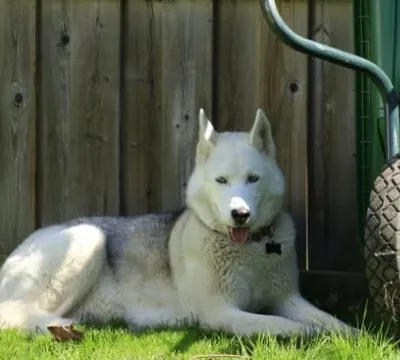 |
A Husky with another dog, showcasing social interaction. |
Introduction
Siberian Huskies are known for their striking appearance, intelligence, and energetic nature. However, their unique behavioural traits can sometimes pose challenges for their owners. Understanding and managing these behaviours is crucial for creating a harmonious living environment. This post will delve into the common behaviours of Siberian Huskies and provide practical tips to ensure a happy and balanced dog.
Common Siberian Husky Behaviors
1. High Energy Levels: Bred as working dogs for pulling sleds over long distances, Huskies require regular, vigorous exercise to stay happy and healthy.
2. Stubbornness: Huskies are independent thinkers, which can sometimes be misconstrued as stubbornness. They may not always follow commands if they do not see the point.
3. Escape Artists: Huskies are notorious for their ability to escape from backyards, houses, and even crates, driven by their high energy levels and curiosity.
4. Social and Pack-Oriented: Huskies thrive in a pack environment and can suffer from separation anxiety if left alone for long periods of time.
5. Vocalization: Huskies are vocal dogs, using a variety of sounds, such as howls, whines, and barks, to communicate.
Tips for Managing Husky Behavior
1. Provide Regular Exercise
Huskies need plenty of physical activity. Aim for at least one to two hours of exercise daily, including walks, runs, playtime, and mental stimulation activities, such as puzzle toys or agility training.
Example: Engage your Husky in activities that mimic their natural instincts, such as sled pulling (urban mushing) or hiking with a weighted backpack.
2. Consistent Training
Use positive reinforcement techniques, such as treats and praise, to reward good behaviour. Start training early and maintain a routine to establish good habits.
Example: Enrol your Husky in obedience classes to reinforce commands and improve socialisation with other dogs.
3. Secure Environment
Ensure your yard has a high, secure fence, and consider using a GPS collar to track your dog if they manage to escape.
Example: Provide a designated digging area in your yard to satisfy your Husky's natural digging instincts without ruining your garden.
4. Social Interaction
If you have a busy schedule, consider getting a second dog for companionship or arranging playdates with other dogs to reduce separation anxiety and keep your Husky mentally stimulated.
Example: Dog daycare facilities can be a great option for Huskies who struggle with being alone during the day.
5. Addressing Vocalization
While some vocalisation is natural, excessive barking or howling can be managed through training and ensuring your Husky's needs are met. Exercise, mental stimulation, and proper socialisation can help reduce unnecessary vocalisation.
Example: Teach your Husky the "quiet" command and reward them when they stop barking on command. In-Depth: Addressing Specific Behavioral Issues
Addressing Specific Behavioral Issues
Separation Anxiety
When left alone, Siberian Huskies can become distraught, leading to destructive behavior, such as chewing, digging, and howling. This anxiety stems from their natural instinct to be part of a pack, making them prone to separation anxiety when their owners are away. To alleviate this distress, it is essential to provide your Husky with adequate exercise, mental stimulation, and training to help them feel secure and independent. This can include gradual separation, interactive toys, and calming aids, such as pheromone diffusers or calming music. By taking proactive steps, you can help your Siberian Husky feel more at ease when you are away, and create a more harmonious home environment.
Example:Start by leaving your Husky alone for short periods and gradually increase the duration
Escape Attempts
Huskies are known for their escape artistry. To prevent this, ensure your yard is secure and provide plenty of mental and physical stimulation to keep them occupied. Training your Husky to return on command can also be helpful.
Example: Invest in a sturdy, tall fence and consider using a GPS collar to track your dog in case they manage to escape.
 |
A secure backyard fence |
Preventing Behavioral Issues
Early Socialization
Introduce your Husky to various environments, people, and other animals from a young age to help them become well-rounded adults and reduce fear or aggression toward new experiences.
Example: Puppy socialization classes can provide structured opportunities for your Husky to interact with others in a controlled environment.
Mental Stimulation
Huskies are intelligent dogs that need mental challenges to prevent boredom. Provide interactive toys, training sessions, and problem-solving games to keep their minds active.
Example: Hide treats around your home or yard, and let your Husky use their nose to find them.
Conclusion
Understanding and managing the unique behaviour of Siberian Huskies is key to ensuring a happy and balanced dog. By providing regular exercise, consistent training, a secure environment, and plenty of social interaction, you can address common behavioural issues and create a harmonious living environment for both you and your Husky. With the right care and attention, your Siberian Husky will thrive and become a beloved member of your family.
Further Reading - [American Kennel Club (AKC) - Siberian Husky](https://www.akc.org/dog-breeds/siberian-husky/) - [Cesar's Way - Understanding Husky Behavior](https://www.cesarsway.com/dog-behavior/siberian-husky/) - [PetMD - Behavioral Problems in Dogs](https://www.petmd.com/dog/behavior) Additional Resources Books: "Siberian Huskies for Dummies" by Diane Morgan "The Siberian Husky: Able Athlete, Able Friend" by Lorie Long Websites: Siberian Husky Club of America ASPCA - Dog Behavior




0 Comments